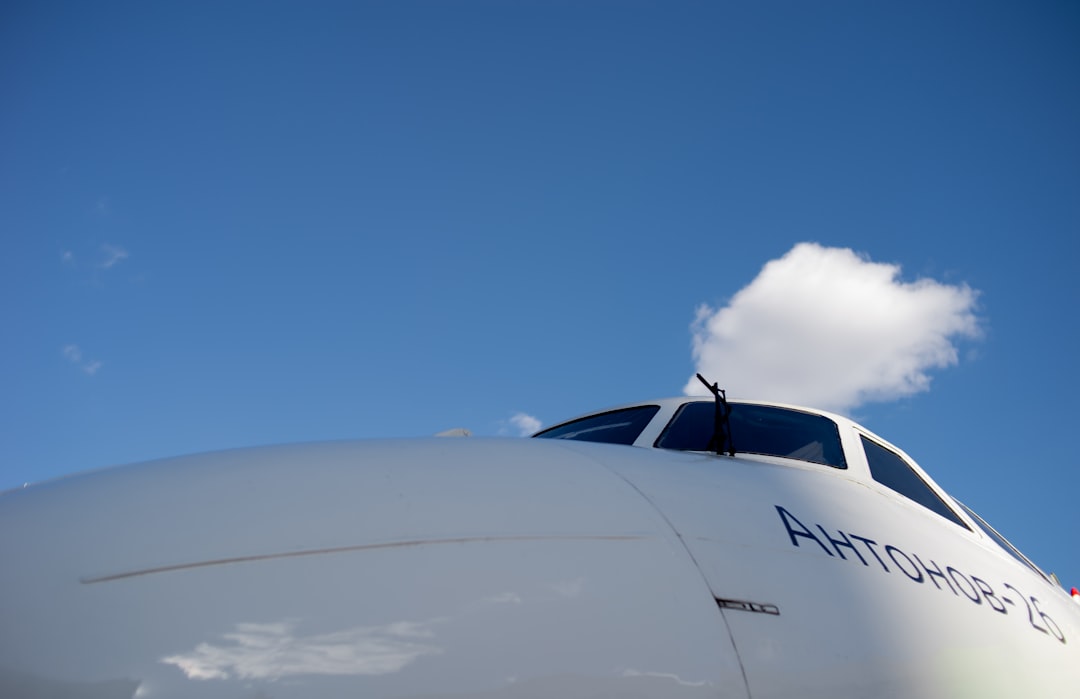

Engage prospects with a scan and streamline customer engagement with FREE QR code marketing tools by Sona – no strings attached!
Create a Free QR CodeFree consultation

No commitment

Engage prospects with a scan and streamline customer engagement with FREE QR code marketing tools by Sona – no strings attached!
Create a Free QR CodeFree consultation

No commitment
QR codes have become a powerful tool for connecting physical experiences to measurable online engagement. For airline training academies, using QR codes bridges the gap between paper-based evaluation forms and actionable, real-time digital feedback without requiring complex setup or apps for staff and trainees. This approach enables quick collection of instructor insights, student satisfaction, and program effectiveness, reducing the risk of missing valuable input that paper workflows can overlook.
Aviation training programs are under increasing pressure to innovate, as trainees and regulatory bodies like IATA demand fast, transparent evaluation and review channels. Relying solely on printed feedback forms can stall improvement cycles and leave important voices unheard, especially if potential leads or trainees are not tracked consistently. Strategic QR code deployment allows feedback collection, streamlined reporting, and improved visibility into engagement signals that might otherwise remain anonymous.
This article explains how airline training academies can use QR code solutions to gather high-quality feedback, improve response rates, and leverage real-time analytics for continuous improvement, helping operations and marketing address common digital and operational gaps.

A persistent challenge in aviation training is missing valuable feedback from instructors and trainees due to time constraints or a lack of digital capture. QR codes make feedback fast, contextual, and mobile-friendly. By placing scannable codes where actions happen, like next to a simulator exit or on classroom whiteboards, academies can capture comments and ratings in the moment when impressions are freshest. This reduces drop-off caused by memory lag and eliminates the paperwork that slows reviews or gets lost in transit.
Replacing analog processes is central to this shift. Paper forms often sit in folders waiting to be keyed into spreadsheets, and emails get ignored after long simulator blocks. QR codes connect directly to digital forms, knowledge bases, and ticketing systems. For structured surveys, consider digital forms like this Google Forms guide. Each scan becomes a data point that can be analyzed by cohort, instructor, or program. With platforms like Sona QR product overview, you can update a destination link without reprinting anything, apply UTM tracking, and stream data to your CRM for faster follow-up.
Here is how to implement this system:
Automated QR code management systems connect all feedback, making it accessible in real time and eliminating visibility gaps that slow decision-making. Start small with one or two high-traffic placements, then scale to cover every touchpoint. As you iterate, use analytics to optimize code placement, messaging, and survey length.
Airline training academies operate in high-stakes environments where every training hour counts. Paper-based surveys, email follow-ups, and untracked conversations waste valuable time and can obscure important signals from trainees and instructors. QR codes reduce friction, capture context, and turn physical moments into digital actions. This results in faster insights, fewer blind spots, and a more responsive quality improvement cycle.
Equally important, QR codes help unify previously disconnected data sources. When scans are tied to cohorts, aircraft types, or specific training devices, your team can identify patterns that manual processes miss. For example, scan activity can reveal that morning simulator sessions have lower satisfaction due to briefing time constraints, or that one classroom consistently reports AV issues.
Strategic QR code adoption accelerates evaluation cycles, improves the trainee experience, and ensures operational issues are addressed quickly. The result is a training academy that listens continuously and adapts quickly.

Choosing the right QR destination and format determines whether your campaigns are simply convenient or genuinely transformative. In aviation training, the most effective codes simplify access to feedback, resources, and support while maintaining flexibility for updates and tracking.
Static QR codes are useful when the destination will never change, such as a safety manual PDF. Dynamic QR codes give you flexibility to update links, add parameters, and capture analytics without producing new printed assets. Most academies benefit from a mix, with a preference for dynamic codes on high-traffic touchpoints.
Dynamic QR codes allow agile updates, granular tracking, and A/B testing. They are especially valuable for iterative training environments where content, schedules, or processes change often.

Growth in aviation education depends on tracking engagement at the moment it happens, a theme echoed in flight school marketing. If you are not capturing intent and feedback when and where people are interacting, your improvement cycles will lag and recruitment pipelines will leak. QR codes turn every surface into a potential growth lever.
Focus on placements with high traffic and clear intent. The more contextual the QR code, the higher the scan rate and the more precise the insights. Do not hide codes in dense posters or place them too high or low. Aim for eye level and provide a benefit-driven CTA that makes the value of scanning obvious.
Strategic placement at these high-impact touchpoints ensures every interaction becomes a data point that informs program delivery, admissions, and resource allocation.

Standard feedback and enrollment mechanisms often miss key data at late stages of the journey. QR codes close these gaps by capturing context-rich signals and routing scanners to the right action quickly. Below are three high-value use cases aligned with common training interactions.
Use Case 1: Real-Time Training Session Feedback
Use Case 2: Course Enrollment and Information
Use Case 3: Alumni Testimonials and Referral Collection
Bridging physical engagement with digital follow-up ensures that valuable leads, insights, and loyalty signals are captured consistently and acted on quickly.
Each QR scan is a micro-signal that reveals interest, timing, and context. By deploying unique QR codes across your academy, you can automatically segment audiences, tailor outreach, and increase the relevance of every message. These segments inform admissions campaigns, course upsells, and alumni engagement without additional effort from staff.
Think beyond a single generic survey link. Use a family of codes that distinguish between prospective students, current trainees, instructors, and alumni. When a scan occurs, the destination can display content relevant to the scanner while your systems tag the interaction appropriately.
With Sona QR, each code becomes a smart entry point to your funnel. You capture real behavior instead of relying on assumptions, which improves both marketing efficiency and learner experience.
Siloed campaigns and untracked leads are common in education environments that rely on heavy print and in-person engagement. QR codes connect offline moments to your digital engine and make every channel measurable. When scans unify with your CRM and attribution tools, you see exactly which materials and events drive the best outcomes. For deeper measurement strategies, explore multi-touch attribution.
An integrated approach helps you balance recruitment and retention. For example, the same campaign that leads prospects to an application can later encourage enrolled trainees to provide feedback, then bring alumni back for mentoring or referrals. QR codes enable this continuity without adding workload for staff.
Centralized QR management ensures campaigns are cohesive and data-driven. You will know which touchpoints deserve more investment and which messages move trainees and prospects from awareness to action.
Ineffective QR efforts usually come from unclear goals, generic content, or poor placement. A simple planning framework keeps teams aligned and ensures that every scan serves a purpose. Use the following steps to move from idea to results with minimal friction.
Start with one use case and one location, then scale to additional programs and facilities. Meet monthly to review scan data, conversion rates, and feedback quality. Adjust your creative, placement, or surveys based on what the data shows, and consider seasonality such as intake periods or simulator maintenance windows when interpreting results.
Clarify the business outcome you want. Examples include increasing real-time feedback in simulator training, improving enrollment completion, or capturing alumni referrals. A specific goal informs which QR format, CTA, and destination you should use.
Select static or dynamic codes based on the need for updates and analytics. Most academy use cases benefit from dynamic codes because they support tracking, retargeting, and rapid content changes without reprinting.
Good design boosts scan rates. A code that blends into the background or lacks context will underperform. Aim for clarity, contrast, and a compelling reason to scan.
Roll out codes to high-visibility locations and materials that match your objective. Avoid trying to place codes everywhere at once. Precision beats volume in the early stages.
Close the loop with analytics, operational follow-up, and iteration. A QR campaign is not a set-and-forget tactic. It is a feedback system that improves with use.
Integrated solutions like Sona QR connect every step, from creation to attribution, turning your QR ecosystem into a visible and optimized feedback and nurturing pipeline.
Without visibility into how scans translate to outcomes, you are guessing. QR analytics show which placements drive engagement, which messages resonate, and which programs need attention. More importantly, they link feedback to action so that trainees see change and continue to participate.
Use analytics to unify offline and online behavior. Combine scan data with website visits, LMS activity, and CRM records to understand the full learner journey. If a trainee rates a simulator session poorly, you can see whether they later accessed remedial materials, scheduled a coaching session, or improved on the next assessment.
With Sona QR and Sona.com, you can capture scan-level detail, unify it with web and CRM activity, and attribute outcomes to the touchpoints that mattered. This turns QR codes from a convenience into a core performance channel.
Even strong QR programs plateau if content gets stale or if staff stop championing the experience. Keep your QR ecosystem fresh and visible with periodic audits, new placements, and incentives that encourage participation without biasing feedback.
Focus on clarity and speed. Trainees and instructors have tight schedules, so every scan should lead to a fast, mobile-first experience. Shorten forms, pre-fill known information, and make next steps obvious. Train staff to point out codes and explain the value: “This helps us improve your next session” or “Scanning here gets you the latest exam prep resources.”
One creative idea: place QR codes on temporary ID badges for visiting candidates so admissions can capture interests and send personalized follow-ups the same day.

Traditional capture methods, like inbox-bound surveys and end-of-term evaluations, rarely reflect the reality of day-to-day training. QR codes shift feedback to the moments that matter, producing more precise insights and better student experiences. The following examples illustrate how academies are using QR codes to improve outcomes.
These scenarios also demonstrate the power of dynamic QR codes. When programs evolve or when you want to test new calls to action, you can update destinations on the fly. Analytics dashboards then reveal what worked and why, so you can standardize successful strategies across departments.
Use these ideas as a starting point. Pilot one example in a single department, measure outcomes, then scale and share playbooks across your academy.
Small details determine whether your QR initiatives soar or stall. Design choices, placement decisions, and follow-up processes all directly affect scan rates and the quality of insights you collect. A little preparation goes a long way.
Avoid treating QR codes as an afterthought. They should be an integral part of your training design, placed thoughtfully where a trainee’s motivation to act is highest. Combine that with consistent messaging and analytics, and your QR programs will continue to compound value over time.
Consistent application of these measures turns QR-driven feedback into a reliable engine for operational excellence and learner satisfaction.
QR codes are more than just shortcuts for information, they are a strategic asset for airline training academies seeking to gather authentic feedback and adapt to changing expectations. By transforming touchpoints into sources of actionable insight, QR codes increase feedback participation and minimize the risk of losing high-value engagement. When combined with a platform like Sona QR, you can generate dynamic codes, centralize analytics, and integrate scan activity with your CRM to trigger the right follow-up at the right time.
With advanced tracking and attribution through Sona QR and Sona.com, academies can connect physical and digital journeys, translate feedback into measurable growth, and stay ahead in aviation education. Start creating QR codes for free. Start with one use case, measure results, and scale your QR footprint as you learn. The sooner you turn physical moments into digital signals, the faster your academy will improve training quality, learner satisfaction, and enrollment outcomes.
QR codes have transformed airline training academies from traditional feedback methods into dynamic, data-driven engagement tools. By enabling instant, mobile-friendly feedback collection, they not only streamline trainee evaluations but also provide actionable insights that improve training effectiveness and safety outcomes. Imagine having real-time access to trainee responses after every session, allowing you to tailor curricula and enhance learning experiences on the fly.
With Sona QR, you can create dynamic, trackable QR codes in seconds, update feedback campaigns instantly without reprinting, and link every scan to measurable improvements in training quality. No more delayed reports or missed opportunities—just smarter, more responsive training programs that elevate academy standards.
Start for free with Sona QR today and transform every scan into valuable feedback that drives continuous improvement and excellence in airline training.
The article does not list specific top airline training academies globally.
Choosing the right airline training academy involves considering factors like program quality, feedback mechanisms, technology use such as QR codes for real-time evaluation, and the academy's ability to track and improve training outcomes.
The article does not specify the qualifications required to enroll in an airline training academy.
The article does not detail specific types of training programs but mentions simulator training sessions, orientation, emergency evacuation drills, and CRM exercises as typical training interactions.
Airline training academies use QR codes to collect real-time feedback from trainees and instructors, replace paper-based surveys, streamline reporting, track engagement, automate workflows, and integrate feedback with CRM systems for continuous improvement.
QR codes reduce feedback friction, capture context-rich data instantly, unify offline and online feedback, enable dynamic updates without reprinting, provide robust analytics, and improve cost efficiency and responsiveness.
Common QR code formats include static codes for fixed content like safety manuals and dynamic codes for feedback forms, enrollment applications, event sign-ups, Wi-Fi access, and app downloads.
Effective placements include simulator exits, classroom doors, briefing areas, orientation materials, facility signage, aircraft mock-ups, event flyers, and alumni lanyards, with clear calls to action at eye level.
Academies can track scan data by location, time, device, and cohort, analyze survey completion rates, integrate scan metadata with CRM and LMS systems, link feedback to outcomes, and use A/B testing to optimize campaigns.
Pitfalls include poor QR code visibility, weak calls to action, slow or complicated feedback experiences, lack of staff training, and stale content without regular updates.
They should place codes where trainees have immediate impressions, use clear and benefit-focused calls to action, keep surveys short and mobile-friendly, train staff to encourage scanning, and refresh content regularly.
Dynamic QR codes allow updates to destinations without reprinting, support tracking and analytics, enable A/B testing, and provide flexible content management, making them ideal for evolving training environments.
The process includes choosing a specific use case and measurable objective, selecting the QR code type, designing and testing the code for clarity and scannability, deploying it in key locations with clear CTAs, and tracking and optimizing performance.
QR codes guide prospects to application forms and info sessions, track conversion, capture alumni testimonials and referrals, and integrate this data with CRM systems to enhance recruitment and retention.
QR codes enable faster, contextual feedback collection, reduce paper-based delays, automate issue routing, unify data sources, and support continuous quality improvements and rapid response to operational issues.
Use Sona QR's trackable codes to improve customer acquisition and engagement today.
Create Your FREE Trackable QR Code in SecondsJoin results-focused teams combining Sona Platform automation with advanced Google Ads strategies to scale lead generation

Connect your existing CRM

Free Account Enrichment

No setup fees
No commitment required

Free consultation

Get a custom Google Ads roadmap for your business






Launch campaigns that generate qualified leads in 30 days or less.
